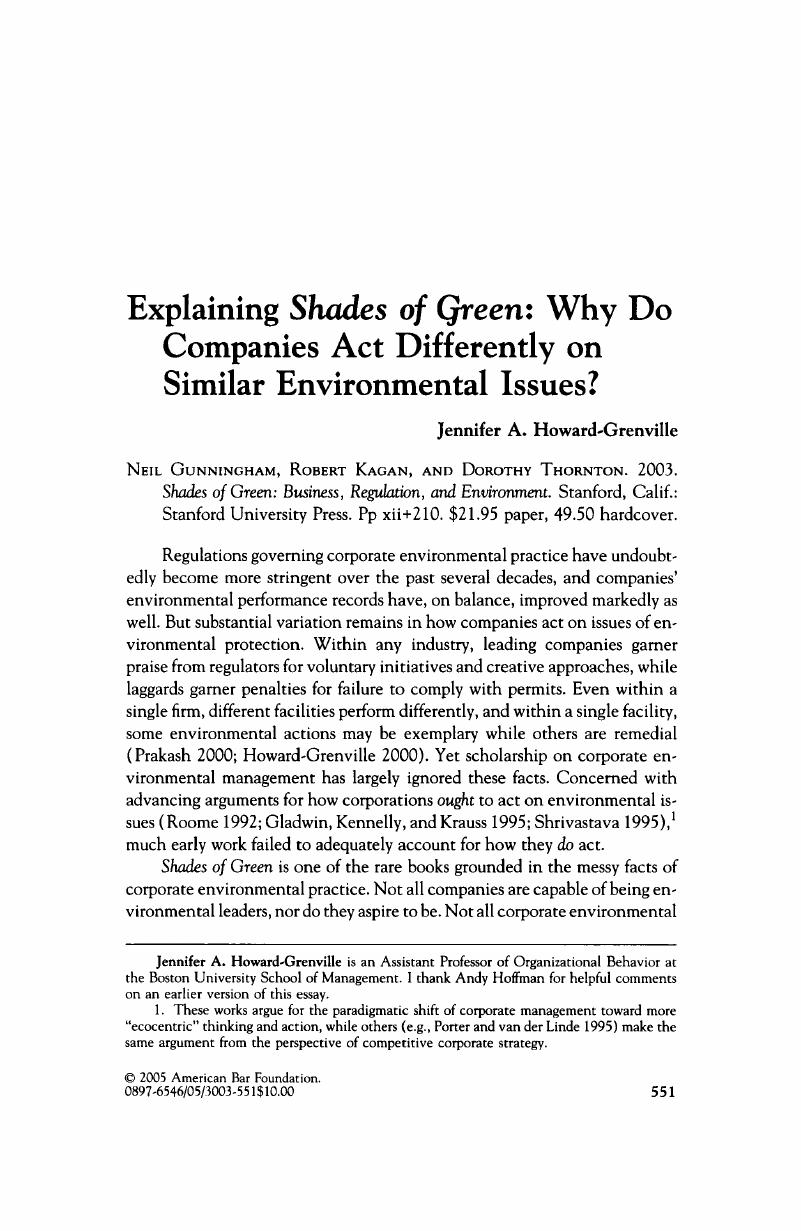Crossref Citations
This article has been cited by the following publications. This list is generated based on data provided by Crossref.
Nottage, Luke R.
2006.
Nothing New in the (North) East? Interpreting the Rhetoric and Reality of Japanese Corporate Governance.
SSRN Electronic Journal,
Howard-Grenville, Jennifer
Nash, Jennifer
and
Coglianese, Cary
2007.
Constructing the License to Operate: Internal Factors and Their Influence on Corporate Environmental Decisions.
SSRN Electronic Journal,
Kerret, Dorit
2008.
ISO 14001 as an Environmental Capacity Building Tool — Variations among Nations.
Environmental Science & Technology,
Vol. 42,
Issue. 8,
p.
2773.
HOWARD‐GRENVILLE, JENNIFER
NASH, JENNIFER
and
COGLIANESE, CARY
2008.
Constructing the License to Operate: Internal Factors and Their Influence on Corporate Environmental Decisions.
Law & Policy,
Vol. 30,
Issue. 1,
p.
73.
Muller, Alan
and
Kolk, Ans
2010.
Extrinsic and Intrinsic Drivers of Corporate Social Performance: Evidence from Foreign and Domestic Firms in Mexico.
Journal of Management Studies,
Vol. 47,
Issue. 1,
p.
1.
Huising, Ruthanne
and
Silbey, Susan S.
2011.
Governing the gap: Forging safe science through relational regulation.
Regulation & Governance,
Vol. 5,
Issue. 1,
p.
14.
Lippert, Ingmar
2011.
Implementing Environmental and Resource Management.
p.
283.
Hawkins, Keith
2013.
Enforcing Regulation: Robert Kagan's Contribution—And Some Questions.
Law & Social Inquiry,
Vol. 38,
Issue. 04,
p.
950.
Talesh, Shauhin
2015.
Rule‐Intermediaries in Action: How State and Business Stakeholders Influence the Meaning of Consumer Rights in Regulatory Governance Arrangements.
Law & Policy,
Vol. 37,
Issue. 1-2,
p.
1.
He, Zheng-Xia
Xu, Shi-Chun
Shen, Wen-Xing
Long, Ru-Yin
and
Chen, Hong
2016.
Factors that influence corporate environmental behavior: empirical analysis based on panel data in China.
Journal of Cleaner Production,
Vol. 133,
Issue. ,
p.
531.
Zoogah, David B.
2018.
High‐performance organizing, environmental management, and organizational performance: An evolutionary economics perspective.
Human Resource Management,
Vol. 57,
Issue. 1,
p.
159.
Linder, Alison
2018.
Explaining shipping company participation in voluntary vessel emission reduction programs.
Transportation Research Part D: Transport and Environment,
Vol. 61,
Issue. ,
p.
234.
He, Zheng-Xia
Shen, Wen-Xing
Li, Qin-bin
Xu, Shi-Chun
Zhao, Bin
Long, Ru-Yin
and
Chen, Hong
2018.
Investigating external and internal pressures on corporate environmental behavior in papermaking enterprises of China.
Journal of Cleaner Production,
Vol. 172,
Issue. ,
p.
1193.
Talesh, Shauhin
and
Pélisse, Jérôme
2019.
Studies in Law, Politics, and Society.
Vol. 79,
Issue. ,
p.
111.
He, Zhengxia
Xu, Shichun
Shen, Wenxing
Wang, Meiling
and
Li, Cunfang
2019.
Exploring external and internal pressures on the environmental behavior of paper enterprises in China: A qualitative study.
Business Strategy and the Environment,
Vol. 28,
Issue. 6,
p.
951.
Constantinescu, Mihaela
and
Kaptein, Muel
2020.
Intrinsic CSR and Competition.
p.
119.
Wang, Yanxia
Shen, Tao
Chen, Yang
and
Carmeli, Abraham
2021.
CEO environmentally responsible leadership and firm environmental innovation: A socio-psychological perspective.
Journal of Business Research,
Vol. 126,
Issue. ,
p.
327.
Evans, Joelle
and
Silbey, Susan S.
2022.
Co-Opting Regulation: Professional Control Through Discretionary Mobilization of Legal Prescriptions and Expert Knowledge.
Organization Science,
Vol. 33,
Issue. 5,
p.
2041.





